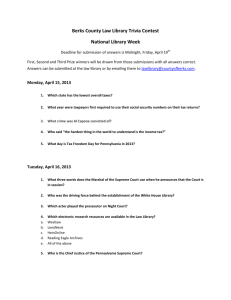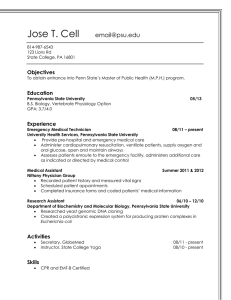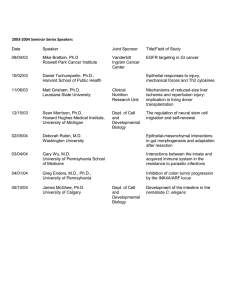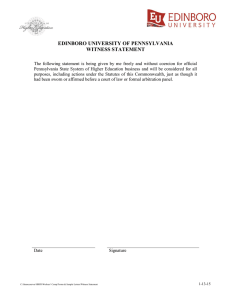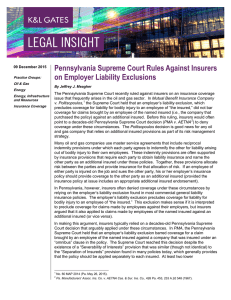Additional Risk: Does Your Company Have Contractors’ Employees?
advertisement
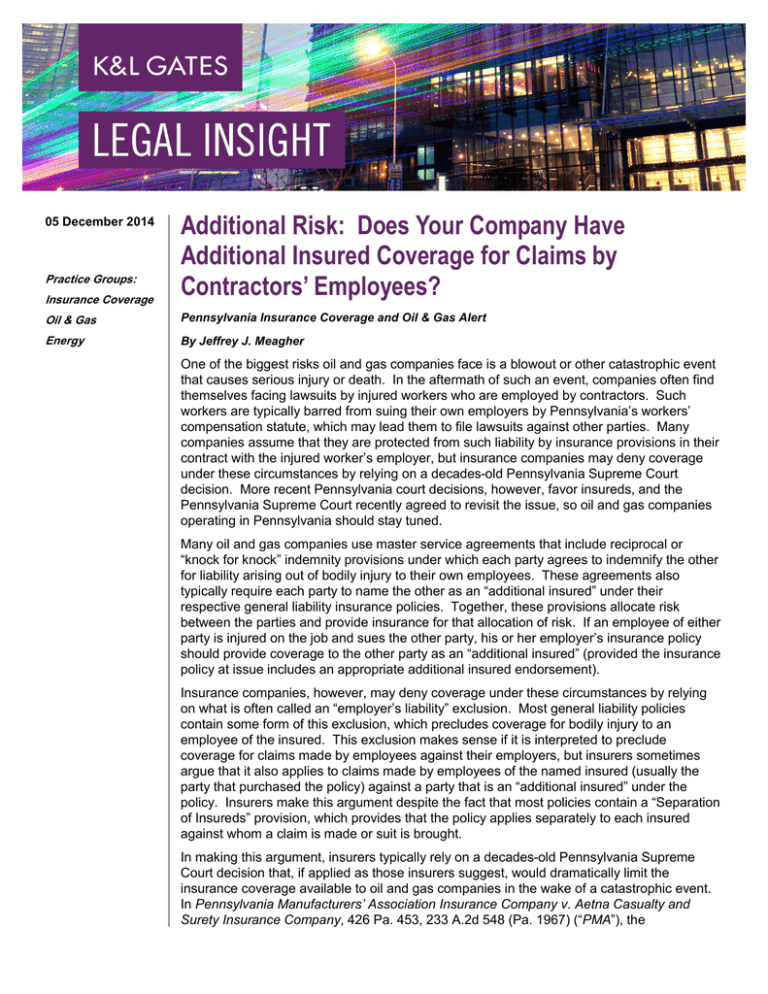
Insurance Coverage Additional Risk: Does Your Company Have Additional Insured Coverage for Claims by Contractors’ Employees? Oil & Gas Pennsylvania Insurance Coverage and Oil & Gas Alert Energy By Jeffrey J. Meagher 05 December 2014 Practice Groups: One of the biggest risks oil and gas companies face is a blowout or other catastrophic event that causes serious injury or death. In the aftermath of such an event, companies often find themselves facing lawsuits by injured workers who are employed by contractors. Such workers are typically barred from suing their own employers by Pennsylvania’s workers’ compensation statute, which may lead them to file lawsuits against other parties. Many companies assume that they are protected from such liability by insurance provisions in their contract with the injured worker’s employer, but insurance companies may deny coverage under these circumstances by relying on a decades-old Pennsylvania Supreme Court decision. More recent Pennsylvania court decisions, however, favor insureds, and the Pennsylvania Supreme Court recently agreed to revisit the issue, so oil and gas companies operating in Pennsylvania should stay tuned. Many oil and gas companies use master service agreements that include reciprocal or “knock for knock” indemnity provisions under which each party agrees to indemnify the other for liability arising out of bodily injury to their own employees. These agreements also typically require each party to name the other as an “additional insured” under their respective general liability insurance policies. Together, these provisions allocate risk between the parties and provide insurance for that allocation of risk. If an employee of either party is injured on the job and sues the other party, his or her employer’s insurance policy should provide coverage to the other party as an “additional insured” (provided the insurance policy at issue includes an appropriate additional insured endorsement). Insurance companies, however, may deny coverage under these circumstances by relying on what is often called an “employer’s liability” exclusion. Most general liability policies contain some form of this exclusion, which precludes coverage for bodily injury to an employee of the insured. This exclusion makes sense if it is interpreted to preclude coverage for claims made by employees against their employers, but insurers sometimes argue that it also applies to claims made by employees of the named insured (usually the party that purchased the policy) against a party that is an “additional insured” under the policy. Insurers make this argument despite the fact that most policies contain a “Separation of Insureds” provision, which provides that the policy applies separately to each insured against whom a claim is made or suit is brought. In making this argument, insurers typically rely on a decades-old Pennsylvania Supreme Court decision that, if applied as those insurers suggest, would dramatically limit the insurance coverage available to oil and gas companies in the wake of a catastrophic event. In Pennsylvania Manufacturers’ Association Insurance Company v. Aetna Casualty and Surety Insurance Company, 426 Pa. 453, 233 A.2d 548 (Pa. 1967) (“PMA”), the Additional Risk: Does Your Company Have Additional Insured Coverage for Claims by Contractors’ Employees? Pennsylvania Supreme Court held that an employer’s liability exclusion barred coverage for a claim brought by an employee of the company that purchased the policy against a company that was insured under an “omnibus” clause in the policy. The Supreme Court reached this decision despite the existence of a “Severability of Interests” provision that was similar (though not identical) to the “Separation of Insureds” provisions used in many policies today. More recent Pennsylvania court decisions have distinguished PMA, but some federal courts have mistakenly concluded that PMA controls. The Pennsylvania Supreme Court recently agreed to revisit this issue when it agreed to hear an appeal of the Pennsylvania Superior Court’s decision in Mutual Benefit Insurance Company v. Politopoulos, 75 A.3d 528 (Pa. Super. Ct. 2013). In that case, a restaurant employee who was injured on the job sued the owner of the property where the injury occurred. The property owner sought coverage as an additional insured under the restaurant’s insurance policy, but the insurance company denied coverage by relying on the employer’s liability exclusion in the policy. The trial court reluctantly held that PMA controlled. The Superior Court distinguished PMA and reversed the trial court’s decision. The Pennsylvania Supreme Court agreed to hear the appeal to decide whether the Superior Court properly ruled that PMA did not control. The Court heard oral arguments on October 7, 2014, but it has not yet issued a decision. Oil and gas companies operating in Pennsylvania should watch for a decision by the Pennsylvania Supreme Court on this issue. In the meantime, those companies should be aware of the issue, ensure that their contracts (and their contractors’ insurance policies) clearly provide for additional insured coverage and consult with coverage counsel when questions or claims arise. Author: Jeffrey J. Meagher jeffrey.meagher@klgates.com +1.412.355.8359 Additional Contacts: David F. McGonigle david.mcgonigle@klgates.com +1.412.355.6233 Thomas E. Birsic thomas.birsic@klgates.com +1.412.355.6538 2 Additional Risk: Does Your Company Have Additional Insured Coverage for Claims by Contractors’ Employees? Anchorage Austin Beijing Berlin Boston Brisbane Brussels Charleston Charlotte Chicago Dallas Doha Dubai Fort Worth Frankfurt Harrisburg Hong Kong Houston London Los Angeles Melbourne Miami Milan Moscow Newark New York Orange County Palo Alto Paris Perth Pittsburgh Portland Raleigh Research Triangle Park San Francisco São Paulo Seattle Seoul Shanghai Singapore Spokane Sydney Taipei Tokyo Warsaw Washington, D.C. Wilmington K&L Gates comprises more than 2,000 lawyers globally who practice in fully integrated offices located on five continents. The firm represents leading multinational corporations, growth and middle-market companies, capital markets participants and entrepreneurs in every major industry group as well as public sector entities, educational institutions, philanthropic organizations and individuals. For more information about K&L Gates or its locations, practices and registrations, visit www.klgates.com. This publication is for informational purposes and does not contain or convey legal advice. The information herein should not be used or relied upon in regard to any particular facts or circumstances without first consulting a lawyer. © 2014 K&L Gates LLP. All Rights Reserved. 3
